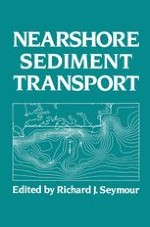1989 | OriginalPaper | Chapter
Offshore Surveys
Author : Robert G. Dean
Published in: Nearshore Sediment Transport
Publisher: Springer US
Included in: Professional Book Archive
Activate our intelligent search to find suitable subject content or patents.
Select sections of text to find matching patents with Artificial Intelligence. powered by
Select sections of text to find additional relevant content using AI-assisted search. powered by
The primary purpose of the offshore soundings conducted in conjunction with the NSTS studies at Santa Barbara, California and Rudee Inlet, Virginia was to determine sediment volumes in water depths too great for standard rod and level surveying procedures employed on the dry beach or in wading depths. Soundings are subject to particular types of errors which can lead to bias in the results and substantially misleading volume errors. These errors at Santa Barbara and Rudee Inlet included: data contamination by dredging, the horizontal position of the survey, the correct temporal and spatial tidal level, the fathometer calibration, the noise introduced into the data by waves and the requirement to survey a sufficient distance offshore to ensure that substantially all of the volumetric changes occurring are being measured. These individual error components and the means taken to minimize them are the subjects of later paragraphs in this section, followed by an overall error assessment viewed in light of the intersurvey volume changes measured. The errors will be discussed in the context of the Santa Barbara measurement program; however, they are similar for the Rudee Inlet study, except dredging occurred more frequently at the latter site. The survey plan for Santa Barbara, California is presented in Figure 3B-1 and comprised a total of 64 beach profiles and 62 sounding lines. Most (59) of the beach profiles and offshore sounding lines were colinear.
